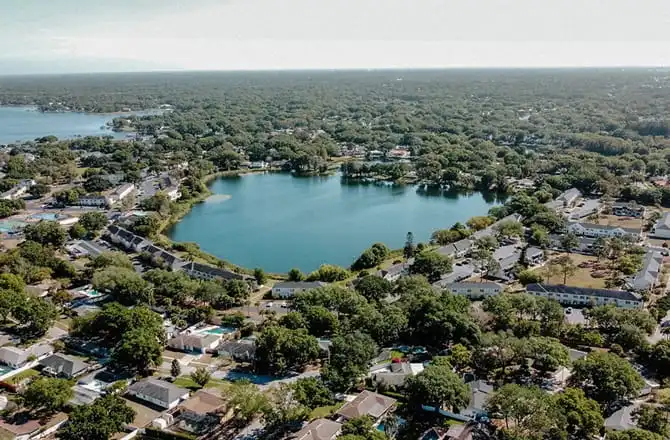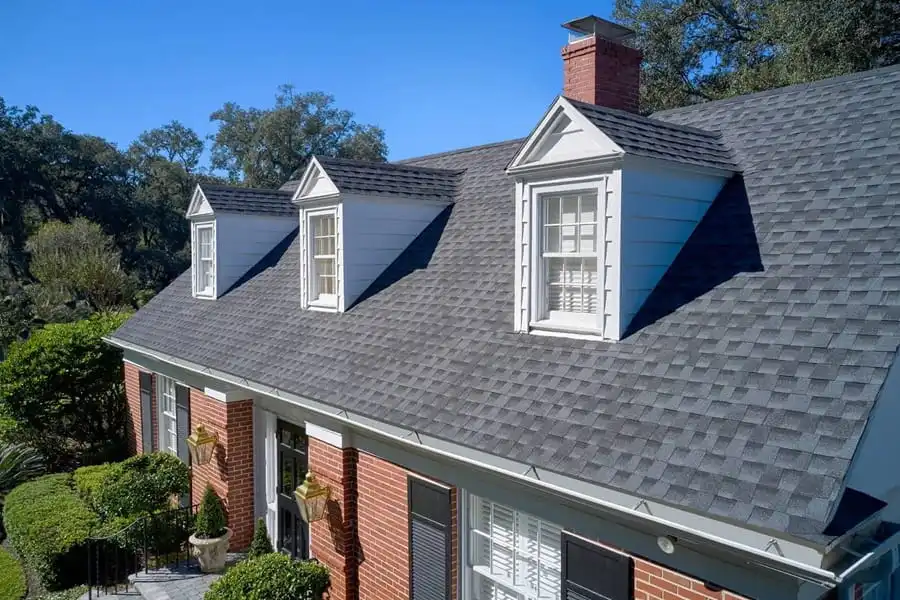When To Replace Roof Flashing in Tampa

Tampa Bay’s mix of heat, humidity, salt air, and storms can wear down even the strongest roof. Over time, flashing around chimneys, skylights, and valleys can loosen or corrode—turning small leaks into major water damage or mold.
If you’ve noticed leaks, rust, or deterioration, start with a detailed roof repair inspection in Tampa with our veteran-led team. VNPS Roofing proudly serves North Tampa and Lake Magdalene homeowners with trusted craftsmanship, honest communication, and lasting results.
What Roof Flashing Does (and Where You’ll Find It)
Roof flashing serves as a watertight barrier, redirecting rain and runoff away from roof penetrations and joints. A skilled roofer installs it around chimneys, skylights, and valleys to prevent water damage to the roof structure and attic.
Common Types
Each part of a roof uses specific flashing to stay watertight. The most common types include:
- Step flashing: Installed where a roof meets a wall (like around dormers), it redirects water away from siding and seams.
- Counter flashing: Covers and seals step flashing, often used around chimneys, to stop water from sneaking behind the base layer.
- Apron flashing: Protects the area where a vertical surface meets a sloped roof, such as at the front of a dormer or chimney.
- Valley flashing: Lines the valleys where two roof slopes meet, channeling water off the roof before it can pool or seep through shingles.
- Drip edge flashing: Runs along roof edges to guide water into gutters and protect the underlying wood or fascia from rot.
- Kickout flashing: Directs runoff away from walls and into gutters, preventing moisture damage and staining on siding.
Want to learn more about the anatomy of your roof? Check out our guide on the Parts of a Roof.
Why It Fails in Tampa
Over time, Tampa’s weather takes a toll. Storms, high wind, and heat cause sealant and caulk to dry out, while corrosion, rust, and salt air degrade metal flashing. Loose fasteners and accumulated debris only worsen wear and tear.
💡 Pro Tip: Most Tampa homeowners discover flashing damage after storms—but early detection saves hundreds in repairs. Checking attic corners, vent seams, and chimney bases for rust or stains every spring and fall can prevent costly leaks.
If you notice lifting shingles or leaks near vents or valleys, check for damage and learn more in our guide on signs you need roof repair.

How Long Roof Flashing Lasts in Tampa’s Climate
The longevity of your roof flashing depends on materials, installation quality, and the surrounding climate. Regular inspection ensures flashing remains watertight and rust-free.
| Material | Average Lifespan | Tampa Notes |
|---|---|---|
| Steel (galvanized) | 15–20 years | Susceptible to rust without proper coating. |
| Aluminum | 15–30 years | Lightweight but prone to corrosion in coastal air. |
| Copper | 40–50+ years | Excellent aesthetics and longevity; higher cost. |
| Stainless steel / coated alloys | 20–30 years | Durable in heavy rain and humidity. |
In Tampa’s humid environment, metal roof components face faster wear. To understand how your entire system performs over time, explore our homeowner guide on how long a roof lasts in Florida.
Signs You Need to Replace Roof Flashing
Watch for these warning signs that your flashing may need replacement:
- Water stains on ceilings or walls
- Rust or corrosion on flashing surfaces
- Cracked or separated sealant and caulk
- Musty odors or visible mold in the attic
- Loose, bent, or missing flashing near roof valleys and chimneys
After a major storm or hail event, schedule a professional roof inspection to prevent emergency repairs and catch leaks early. For detailed guidance, read our educational post on roof leaks in Tampa: causes & signs.
Replace vs. Repair — Practical Rules of Thumb
Replace
- It shows signs of corrosion, rust, or cracking
- It’s separated from the roof or causing chronic leaks
- A new roof replacement is underway
- The underlying deck or roof tiles show water damage
If the flashing failure is widespread, consider a full roof replacement in Tampa to restore waterproofing and system warranty protection.
Repair
- The metal is structurally sound and only the sealant has failed
- Minor gaps can be re-caulked or fasteners resecured
- The damage is isolated to one small section
Always have a licensed roofing company handle flashing repairs to protect your warranty and ensure quality construction.
For homeowners in North Tampa, we also offer localized support through our roof replacement services in Lake Magdalene.

Inspection Cadence for Tampa Homes
Regular inspections help catch flashing issues before they become costly problems. In Tampa, follow this schedule:
- Annual inspections: At least once every 12 months to check for rust, loose fasteners, or sealant wear.
- After storms: Inspect promptly after heavy rain, wind, or hail.
- Coastal or salt-exposed homes: Consider inspections every six months to prevent corrosion.
- Older roofs: Roofs over 15 years may need more frequent checks due to natural wear.
For proactive care, see our preventive guide on roof maintenance in Lake Magdalene to extend the life of your roofing system.
What Affects Flashing Replacement Cost
The cost to replace roof flashing in Tampa varies depending on several factors:
- Material type: Steel, aluminum, copper, or stainless steel each have different price points and lifespans.
- Roof pitch and accessibility: Steeper roofs or difficult-to-reach areas increase labor costs.
- Location and complexity: Flashing around chimneys, skylights, valleys, or dormers requires more precision and time.
- Extent of damage: If water has compromised the roof deck or shingles, additional repairs may be necessary.
- Roof system integration: Asphalt shingles, tiles, or flat roofs may affect flashing installation complexity.
- Permits and codes: Compliance with Florida building codes or insurance requirements can add to cost.
If damage extends beyond flashing, your contractor may recommend a full roof replacement in Tampa for long-term value. For homeowners researching average pricing and materials, check out our detailed article on roof replacement cost in Tampa for real-world estimates.
Why Choose VNPS Roofing for Flashing Work
As a veteran-owned, local roofing company, we’re proud to serve Hillsborough, Pinellas, and Pasco Counties with reliable service and lasting workmanship.
Here’s what sets our team apart:
- Over 40 years of combined experience in roof repair and replacement
- Skilled with asphalt shingle, metal roof, and flat roof systems such as bitumen and TPO
- Specialists in copper and stainless steel flashing for long-term strength and refined aesthetics
- Known for dependable storm restoration, emergency repairs, and outstanding customer service
- Every project backed by strong warranties and full compliance with Florida building codes
Whether you’re repairing flashing or replacing your entire roof, VNPS Roofing delivers the same commitment to quality and craftsmanship on every job.
If you’ve noticed cracked paint, sagging wood, or moisture near your roofline, visit our page on soffit and fascia repair in Tampa to keep your home sealed and protected from future leaks.

FAQs
Q: How often should roof flashing be replaced?
A: Inspect yearly and after major storms. Replace when metal is rusted, loose, or leaking, when sealant has failed, or as part of a full roof replacement. Typical replacement cadence is 15–25 years depending on material and exposure.
Q: How long does roof flashing last in Tampa?
A: Steel: 15–20 years; aluminum: 15–30 years; copper: 40–50+ years. Heat, humidity, salt air, and wind-driven rain can shorten lifespan. Proper installation and routine maintenance extend service life.
Q: Should flashing be replaced with a new roof?
A: Yes. Best practice is to replace or properly reinstall flashing during a reroof to maintain waterproofing, meet code/manufacturer specs, and protect warranties.
Q: Can you repair flashing without replacing the roof?
A: Yes for minor issues—reseal or refasten if the metal is sound and leaks are limited to sealant/fasteners. Replace the flashing if it’s bent, corroded, split, or causing recurring leaks.
Q: What is the 25% rule for roof replacement in Florida (and does it impact flashing)?
A: Florida rules address how much of a roof section can be repaired vs. replaced. Since 2022 updates, compliant roofs can often be repaired instead of fully replaced. Flashing is typically updated as part of permitted roof work to meet current code and manufacturer standards.
Q: What affects flashing replacement cost in Tampa?
A: Factors include material type (steel/aluminum/copper), roof pitch and access, location/complexity, extent of water or deck damage, roof covering tie-ins, number of roof penetrations, required permits/code items, and whether work is bundled with a reroof.
Schedule Your Roof Flashing Inspection in Tampa
Don’t wait until a small leak turns into major water damage. Our Tampa roofers take pride in providing clear communication, honest estimates, and fast response times after heavy rain or severe weather. We’ll check every vulnerable area of your roof—from chimneys and skylights to valleys and gutters—so you can feel confident your home is protected.
Ready to get started? Contact our Tampa roof repair experts today or request a free inspection through our online quote form.

